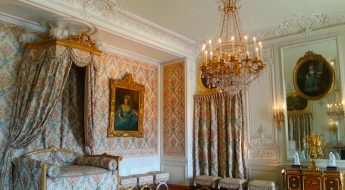A Childhood at Versailles consists of the first 5 chapters of the memoirs of Mme de Boigne (1781-1866), née Adèle d’Osmond, who was a French salon hostess and writer. She was born in the Château de Versailles and lived at the court of Louis XVI and Marie-Antoinette until her family fled to England during the Revolution. Later in her long life, she married a rich soldier of fortune 30 years her senior, hosted a brilliant salon in Paris, and became an intimate of the last French queen, Marie-Amélie, consort of King Louis Philippe (r. 1830-1848). Childless herself, Mme de Boigne addressed her memoirs to her nephew. The memoirs were not published until 1907, under the title Récits d’une tante, or An Aunt’s Tales. They’ve never been published in English, as far as I know, so I’ve decided to translate the first 5 chapters, the ones that take place mainly at Versailles, and post them here on this blog for interested readers to enjoy for free.
The chapters are quite lengthy, so I’ve broken each one into several parts. In Part 1.4, Mme de Boigne discusses the fearsome protocol. “l’étiquette,” that governed life at court, not only at Versailles, but at every one of the royal residences.
“Among the protocols at Versailles, there was one to which my father could never reconcile himself and of which I often heard him speak, which was the way of being invited to what was called the souper dans les cabinets. The guest list for these suppers consisted of the royal family and about thirty invited guests. They took place in the King’s private apartments, in rooms with so little space that the billiard table had to be covered with planks in order to put the buffet on it. The King was forced to rush his game in order make way for the food.
The ladies had been warned that morning or the evening before. For the occasion, they wore sack-backed gowns, an antiquated costume that had long fallen out of fashion in any other circumstance. They presented themselves at the small theatre, where a bench was reserved for them. After the performance, they followed the King and the royal family into the private apartments.
As for the men, their fate was less gentle…
There were two benches across from that of the invited ladies. The courtiers who aspired to an invitation took their places on these benches. During the performance, the King, who was alone in his box, trained his big opera glasses on these benches, and he could be seen writing a certain number of names in pencil. The lords who had been occupying the benches — it was called presenting oneself for the private apartments — gathered in the room before the entrance of the private apartments after the performance.
Soon after, an usher, candle in hand and holding the little paper written on by the King, opened the door and announced a name. The fortunate invitee bowed to the others and entered the holy of holies. The door opened again, another name was called, and so on until the end of the list was reached. After the last name was called, the usher slammed the door shut with a violent bang that was required by protocol.
At the sound of this noise, everyone else knew that his hopes had been dashed and always went away somewhat abashed, even though one knew well in advance that there would be many more candidates that invitees. My mother told me that it had taken years for her to talk my father into taking a seat on those benches. In the end, although he did go from time to time, and was called fairly often, he nevertheless found it all extremely disagreeable. He had seen a man come from Paris for ten years in a row to present himself for the private apartments, only to hear the door slam on his ambitions every time and never once open for him. Too much perseverance perhaps irritated the King, or perhaps he became used to seeing people without inviting them, just as princes easily get into the habit of always asking the same questions to the same people.
The Queen’s balls were taken for granted. Those who had been presented at Court were told that they were going to take place. Anyone who wanted to could come, and many people did want to because they were charming. They were held in wooden houses that were set up on the terrace at Versailles, and which remained there throughout the Carnival; however, these balls, too, despite the Queen’s charming graciousness, occasioned unpopularity for the Court.
The growth of private fortunes amongst the middle classes had brought with it all the manners and habits of the best company, and despite the absurd ordinance that required proofs of nobility in order to become an officer, anyone who had any means and education entered military service. Nobility and finance thus lived together in an intimate and comradely way in the barracks, and also in every circle in Paris; the balls at Versailles, however, re-drew the line of demarcation in the most definite way. M de Lusson, a young man who cut the most charming figure, immensely rich, a good officer, and accustomed to mixing with the best company, had the imprudence to attend one of these balls. He was turned away with such harshness that, desperate at the ridicule with which he was covered, at a time when ridicule was the worst of all ills, he killed himself on arriving in Paris. This seemed quite straightforward to the people at Court, but odious to the upper bourgeoisie.
It was not only finance that furnished victims to the Queen’s balls. M de Chabannes was illustrious of birth, handsome, young, rich, and fashionable; making his debut at a ball, he was so gauche as to slip when dancing, and so silly as to exclaim “Jesus and Mary!” on his way down. He was never able to recover from that fall. The sobriquet stuck to him forever; it made him desperate. He went off to the war in America, and acquitted himself quite well there, but he came back as “Jesus and Mary,” just as he had left. The Duc de Guines, too, said to his daughters on the day of their presentation at Court, “Remember that here vices are of no consequence, but ridicule kills.”
M de Lafayette, nonetheless, did not succumb to the epithet “Gilles le Grand”5 that M de Choiseul conferred on him on his return from America. To the contrary, he inspired such enthusiasm that society took it upon itself to pave his way to success with Mme de Simiane, to whom he had given marks of devotion before his departure. She was thought to be the prettiest woman in France, and had never had an affair. Everyone conspired to push her into M de Lafayette’s arms, to such an extent that a few days after his return, the audience at the opera house at Versailles, seeing them together in a box during I know not which opera, applauded them while the aria “Love under laurels is never cruelly rejected,” was being sung, in such a way that the sympathy and approval of that select audience could not have been expressed more clearly.
I remember overhearing my mother recount that she had procured a seat for her sister, the Présidente de Lavie, who had come up to Paris on a trip, to attend one of the Queen’s balls as a spectator. While she was talking to her sister at the ball, the Queen approached and asked who this beautiful creature was:
“This is my sister, Madame.”
“Has she seen the ballroom?”
“No, Madame, she is a spectator. She has not been presented.”
“You must show it to her. I shall take the King out.”
And, indeed, she was as good as her gracious words, taking the King’s arm and leading him into the other rooms while my mother showed my aunt around the ballroom. The Queen’s intention had been to be obliging, but Président de Lavie took it otherwise. He was of ancient stock, very infatuated with his noble status, and a personage of great standing in Bordeaux, where a president of the Parlement played a great role in public life. He was indignant that it was necessary for the King and Queen to leave a room in order for his wife to enter it. He returned to Bordeaux more of a rebel than he had been when he left it; later named a deputy, he proved to be very revolutionary. The prospect of humiliating the Court nobility had seduced him. Wounded vanity makes more enemies than one would think.
The protocol adopted for special celebrations and the “voyages” to other royal residences would seem unbearable today. First, one went to enrol — for so it was called — which is to say one went to the First Gentleman of the Bedchamber’s, where one wrote one’s name in one’s own hand on a piece of paper. The choice of invitees was made from this list by eliminating those who would not be invited, with the result that a non-invitation took on the humiliating character of a rejection. Madame la Dauphine,6 was said to have wanted to revive this practice during the Restoration for the fairly infrequent performances at Court. However, it could never have been reinstated, for no one wanted to be forced to go write down his name if there was a chance of being rejected. It was felt that it was less disagreeable not to be invited than to be knocked back.
For the voyages, the customs varied according to the residence. At Rambouillet, where the King only went for a few days and only with men, one was received as at the home of a rich commoner, with perfect service and everything taken care of. At Trianon, where the Queen also only went on rare and short visits, and with very few people, it was the same. At Marly, one was given lodgings, furniture, and meals. The guests in residence were distributed to various tables presided over by the princes and princesses in their respective pavilions, at the King’s expense. Afterwards, one gathered in the big salon, where a regular Court was held.
At Fontainebleau, the guests were given only rooms with four walls. One had to procure furniture, linens, etc., and apply one’s ingenuity to live there. In truth, as all the ministers and all the charges had their own houses there, and since the princes kept tables for all the people who accompanied them, it was easy to get oneself invited to dinner and supper. However, no one bothered about your accommodation. When the chateau was full, and a large part of it was in such a bad state that it was uninhabitable, the guests, or rather those who had been admitted, for one had to enrol, were distributed in the town; their names were written in chalk on doors, as at an overnight stop at the end of one stage of a journey.
I do not know if these lodgings were paid for, but the benefits conferred by these voyages on Fontainebleau were great enough that the inhabitants did not complain of their servitude. Everyone knows that nowhere did the Court of France put on a more magnificent show than at Fontainebleau. It was on the stage of its little theatre that the most carefully prepared premieres were performed, and it was almost an open secret that ministerial intrigues came to their climax at Fontainebleau, apparently to continue the historic existence of this beautiful residence. The last voyage took place in 1787. Despite the seeming lack of hospitality that the voyages to Fontainebleau occasioned, they cost the Crown dearly. The King, always ready to sacrifice his own pleasures, gave up his stays there even though they were very agreeable to him. He was kinder at Fontainebleau than elsewhere, and spent more liberally there.”
Notes:
5. An 18th century theatrical character; a fool.
6. Madame Marie-Thérèse, Duchesse d’Angoulême, daughter of Louis XVI, only became Dauphine on the death of Louis XVII. (Mme de Boigne’s editor is in error here. The Duchesse d’Angoulême became Dauphine on the accession of her father-in-law and uncle, Charles X, in 1824.)
I present Mme de Boigne’s text without footnotes other than the ones that were included in the first edition of her memoirs. If you have any questions about any of the information, please comment. If you’ve enjoyed this passage, please share it!


















Leave a Comment